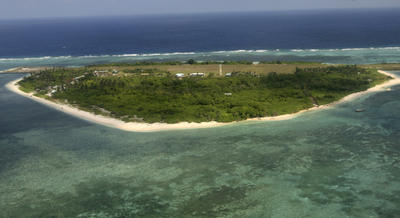In the past, this communiqué has served to summarise the agreements that have been achieved throughout the year and what things are on the agenda for the future.
Unresolved issues have usually been omitted from the communiqué, in the typical ASEAN expectation that they would sort themselves out over time. This comfortable premise was shattered in Phnom Penh. The Philippines and Vietnam insisted that their clashes with China over conflicting territorial claims should be aired. In April, Chinese and Philippine ships confronted each other over the Scarborough Shoal, or Huayang Reef, as the Chinese call this string of islets. As reported in Indonesia the Philipinnes’ foreign minister, Albert del Rosario, is said to have accused the Chair, Cambodia’s Foreign Minister Hor Namhong, of ‘consistently defending China’s interest’ — in a very un-ASEAN way. And the Chair refused to comply with the wishes of the Philippines and Vietnam, although the South China Sea issue had been mentioned in the chairman’s statement after the ASEAN Summit in Bali last November, when Indonesia was host. Vietnam’s clash with China erupted after Chinese vessels interfered with Vietnamese drilling operations in what Hanoi claims as its exclusive economic zone (EEZ). The Vietnamese case is emblematic of the paradoxes of history, as Vietnam’s strategic victory over America in 1975 has been replaced by the embrace of its former enemy and the welcome of its navy into Cam Ranh Bay as a hedging strategy against its traditional adversary, China. At the same time, Hanoi is maintaining a bilateral back-channel with Beijing — a brilliant application, according to Indonesian commentary, of Indonesia’s concept of ‘dynamic equilibrium’.
One view of the very un-ASEAN events in Phnom Penh is that failure to produce a communiqué that merely papered over serious differences was a sign of ASEAN’s maturity. An alternative and more disconcerting view is that this incident was a preliminary skirmish that juxtaposes China’s and the United States’ influence in Southeast Asia. The US pivot toward Asia after President Obama’s Canberra speech could be seen as gaining traction through the representations of America’s proxies.
Yet, what is equally clear is that what US military leaders fear most in Southeast Asia is being dragged unwittingly into confrontation with China by allied parties over issues that are not central to US strategic interests. In Canberra over the past couple of weeks that was the key message from US Pacific Command to anyone listening carefully.
So it remains in everyone’s interests — the interests of the Chinese, Filipino and Vietnamese protagonists, those spoiling for a brawl over ‘moral outrage’ in America, and those predicting apocalypse now between America and China — to cool it and look carefully at the issues over which there has been contention. The region has been well-served in this respect by the shuttle diplomacy of Indonesia’s foreign minister, Marty Natalegawa, who sought to restore ASEAN amity and reasonableness. As he said: ‘Once the dust settles, we have to ask ourselves, what is next? We need to be clear on what is ASEAN’s interest in this issue. We [ASEAN] need to assert our centrality’.
Sourabh Gupta provides timely adult supervision on the substance at issue. As he says: ‘At the end of the day, ultimate title cannot be said to rest with any one party so long as a territorial claim is not resolved by way of a binding instrument between claimant states. At best, there are better claims and less-better claims to the territory in question’. While Gupta concedes that China’s legal claims are markedly superior to those of others’, ‘territorial jurisdiction issues have never been treated as mere cartographic detail: they are tied to a larger political calculus of stability and good neighbourliness. In its maritime dimension, joint development of commonly-held resources has been the established mode to implement this principle’.
‘Given the fast-paced development of international maritime law, which is accentuating the gap between political calculus-based and rules-based orders at sea’, Gupta concludes, ‘it is in China’s self-interest to submit a Law of the Seas-compliant claim to its outer continental-shelf limits in the South China Sea’.
If this were done in good time, as things are cooled, Beijing’s gains in goodwill are likely to far outweigh any territory, and resources, relinquished. And that might also allow leeway for China to subsequently initiate a region-wide conversation on ‘introducing limits to objectionable, threat-based activities in EEZs by foreign navies, under the guise of navigational freedoms’.
Peter Drysdale is Editor of the East Asia Forum.

